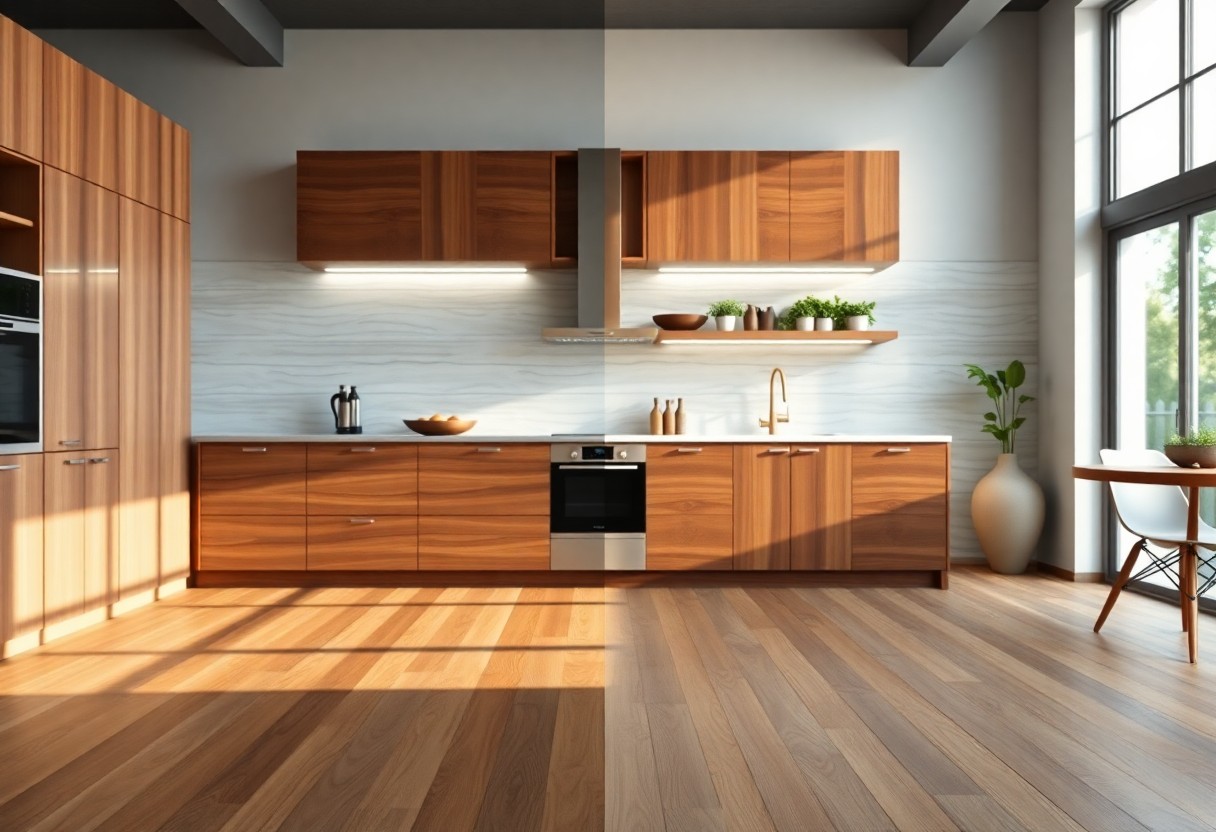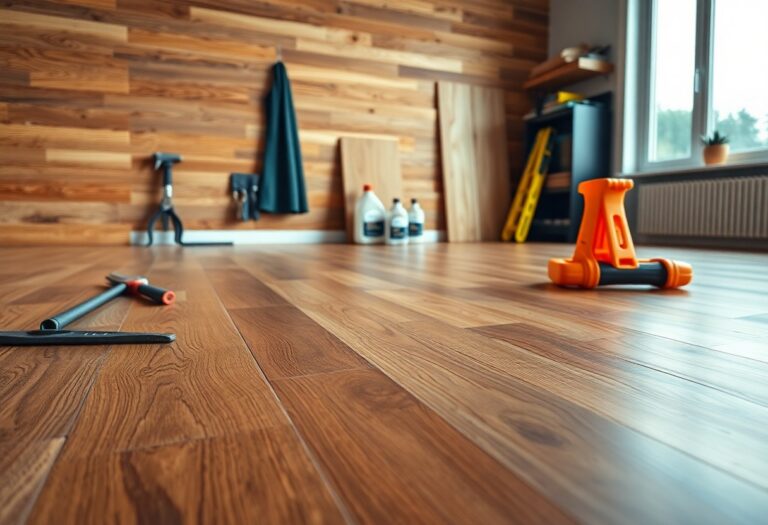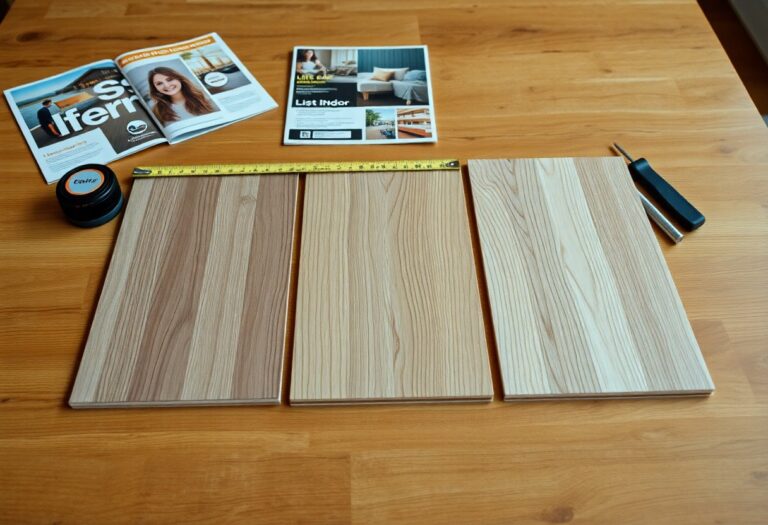Over the years, choosing the right flooring has become a significant decision for homeowners in Kitchener, and understanding the differences between hardwood and laminate is vital. Each option presents unique benefits and considerations that can impact the aesthetic and functionality of your space. As you explore these flooring types, you’ll want to weigh factors such as durability, maintenance, and cost to ensure you make the best choice for your kitchen. Dive into this guide to help you navigate your flooring options and find the perfect fit for your home.

The Aesthetic Appeal of Flooring Options
The visual character of your space is significantly impacted by your choice of flooring. In Kitchener, where homes reflect a mix of modern and traditional styles, flooring options like hardwood and laminate can enhance your interior with their unique aesthetics. While hardwood offers an organic charm, laminate can provide a sleek, contemporary look. Both can complement your design vision, depending on your style preferences and the overall theme of your home.
Hardwood: Timeless Beauty and Versatility
Hardwood flooring radiates a natural elegance that never goes out of style. With an array of species and stains available, you can create a warm, inviting atmosphere that seamlessly blends with various decor styles—from rustic to modern. The grain patterns and unique textures of hardwood planks add character, making each installation truly one-of-a-kind. This versatility ensures your flooring remains a stunning backdrop for your kitchen and dining experiences.
Laminate: Modern Styles and Customization
Laminate flooring breaks traditional barriers with its ability to mimic hardwood while offering more contemporary styles. The variety of colors, patterns, and textures allows you to customize your space to match your individuality. With designs that replicate natural wood or even abstract patterns, laminate offers endless possibilities that can align perfectly with your kitchen’s aesthetic.
This adaptability of laminate is especially appealing in today’s design landscape. State-of-the-art printing technology enables laminate manufacturers to create realistic wood grain effects and textures that can fool even the keenest eye. With numerous options ranging from light, airy tones to dark, dramatic finishes, you can achieve a custom look that suits your taste and lifestyle, all while remaining budget-friendly. Plus, since laminate is also durable and easy to maintain, you can enjoy a stylish kitchen without sacrificing practicality.
Durability and Maintenance: A Comparative Analysis
Understanding the durability and maintenance needs of your chosen flooring is vital to ensuring its longevity. Both hardwood and laminate have their unique strengths and weaknesses, which might influence your choice based on your lifestyle, family dynamics, and personal preferences. Below is a comparative analysis to guide you.
| Feature | Hardwood | Laminate |
|---|---|---|
| Durability | Durable; can last decades with care | Highly durable; resistant to scratches |
| Water Resistance | Vulnerable to water damage | Water-resistant options available |
| Maintenance | Requires regular polishing | Low maintenance; easy to clean |
| Refinishing | Can be refinished multiple times | Cannot be refinished |
| Cost of Repair | Higher repair costs | Lower repair costs |
| Scratch Resistance | More prone to scratches | Very scratch resistant |
| Stains | Can stain if spills aren’t cleaned | Stains less likely |
| Environmental Factors | Can warp in humidity | Stable in varying climates |
| Longevity | Can last for generations | Lasts 15-25 years on average |
Hardwood Resilience: Pros and Cons
Investing in hardwood flooring delivers a combination of timeless elegance and enduring durability when adequately cared for. However, its susceptibility to moisture and scratches may require more vigilant maintenance. To help you weigh the benefits and drawbacks, here’s a concise summary:
| Pros | Cons |
|---|---|
| Long-lasting and can be refinished | Higher initial cost |
| Improves home value | Vulnerable to scratches |
| Timeless aesthetic | Sensitive to moisture |
| Unique character with natural variations | Requires regular maintenance |
| Warm feel underfoot | Can be cold in winter without heating |
| Good for indoor air quality | May warp with humidity changes |
Laminate Longevity: Benefits and Limitations
Laminate flooring provides a budget-friendly alternative that mimics the appearance of hardwood while boasting higher durability in terms of scratches and stains. Its lifespan typically ranges between 15 to 25 years, depending on quality and usage, but it is not an option you can refinish as you would with hardwood. Its water-resistant variations make it appealing for high-traffic and moisture-prone areas, such as kitchens or bathrooms, though direct exposure to standing water should be avoided. Consider your lifestyle and maintenance preferences when deciding on laminate for your space.
Cost Considerations: Budgeting for Your Space
Understanding the financial implications of flooring options is fundamental to making an informed decision. Both hardwood and laminate come with their own price tags, which can significantly impact your overall budget. As you evaluate your options, consider not only initial purchase costs but also long-term expenses associated with maintenance and potential repairs.
Initial Investment: Hardwood vs. Laminate
The upfront cost varies notably between hardwood and laminate. On average, solid hardwood can range from $5 to $15 per square foot, while high-quality laminate typically falls between $1 to $5 per square foot. Although hardwood offers a classic, timeless appeal, laminate provides a more budget-friendly option, allowing you to achieve a similar aesthetic without straining your finances.
Long-Term Costs: Maintenance and Repairs
Owning hardwood requires more ongoing investment than laminate. Hardwood needs regular refinishing every 5 to 10 years, which can run between $3 and $8 per square foot, whereas laminate only requires a simple cleaning routine and, if damaged, can be easier to replace in sections rather than refinishing an entire floor.
Investing in maintenance is imperative for hardwood to retain its value and appearance over time. The refinishing process not only restores its surface but also adds durability, extending its life. Laminate, designed to resist scratches and moisture better, typically incurs fewer long-term costs. Replacing damaged planks can be more cost-effective, preventing the distress that comes with trying to match and repair the wood grain of hardwood. When budgeting, weigh these aspects against your lifestyle needs and how long you plan to remain in your Kitchener home.
Environmental Impact: Sustainable Flooring Choices
Choosing flooring that aligns with your values on sustainability can greatly influence the environmental footprint of your home. Both hardwood and laminate have varying ecological impacts based on their sourcing, production, and potential for recycling. Understanding these facets will help you make an informed choice that not only enhances your kitchen’s beauty but also contributes positively to the planet.
Hardwood Sourcing and Ecological Effects
Hardwood flooring originates from trees, and the ecological effects depend largely on responsible sourcing. Sustainably harvested woods come from managed forests that maintain biodiversity, preserve natural habitats, and ensure the ongoing health of ecosystems. However, non-sustainable practices can lead to deforestation, carbon footprint increases, and loss of wildlife. Ensuring certification from credible organizations like the Forest Stewardship Council (FSC) can guide you to environmentally friendly options.
Laminate Production and Recycling Potential
Laminate flooring, made with composite materials and a photographic layer resembling wood, has its own environmental considerations. While the production process often utilizes less wood than hardwood, resulting in lower deforestation rates, it typically involves chemicals and plastic derivatives, which can pose disposal challenges. However, the good news is that many manufacturers are adopting eco-friendlier production methods and creating laminate that can be recycled more effectively, reducing landfill impact.
The production of laminate flooring is often seen as more energy-efficient than that of hardwood, primarily due to the use of recycled materials and lower energy consumption in the manufacturing process. Innovations in laminates have led to the development of eco-friendly products made from recycled wood and sustainable resins. Additionally, many laminate options are now designed for recyclability, allowing you to divert materials from landfills at the end of their life cycle. Choosing laminate that emphasizes these practices supports a more sustainable flooring choice for your home.
Practicality for Kitchener Homes: Climate and Use
Your choice of flooring must consider Kitchener’s unique climate and the specific use of your space. With cold winters and warm summers, hardwood may require more maintenance to combat humidity and temperature fluctuations, while laminate offers a more resilient option against warping or buckling. Both flooring types can serve well depending on your lifestyle and the demands of your household, so evaluating these factors will be key to achieving the right balance of aesthetics and function.
Suitable Flooring for Seasonal Changes
Impact of Lifestyle on Flooring Choice
Your lifestyle significantly influences the best flooring option for your home. If you have children or pets, a durable surface is paramount, making laminate a strong contender due to its scratch resistance and ease of cleaning. Conversely, if you enjoy entertaining or prefer a classic aesthetic, hardwood may enhance your space’s warmth and character. Weighing your day-to-day activities—like high foot traffic versus a more relaxed environment—can help determine which flooring aligns best with your needs.
Active households or those that frequently host guests benefit from durable flooring that can handle spills, scuffs, and wear and tear over time. High-traffic areas, such as kitchens and hallways, may see laminate shine here since it can sustain daily use without losing its luster. On the flip side, if your lifestyle leans towards luxury and elegance, the long-term investment in hardwood can provide both durability and timeless appeal. Assessing your daily routine and how you utilize your space will ultimately guide you towards the flooring choice that best complements your lifestyle.
Final Words
Drawing together the aspects of hardwood and laminate flooring, it’s crucial to consider your unique needs and preferences for your Kitchener space. Hardwood offers timeless beauty and durability, while laminate provides affordability and ease of maintenance. Think about factors such as your lifestyle, budget, and the overall aesthetic you wish to achieve. Ultimately, the right choice will enhance your home’s appeal and function, ensuring you enjoy your flooring for years to come.





